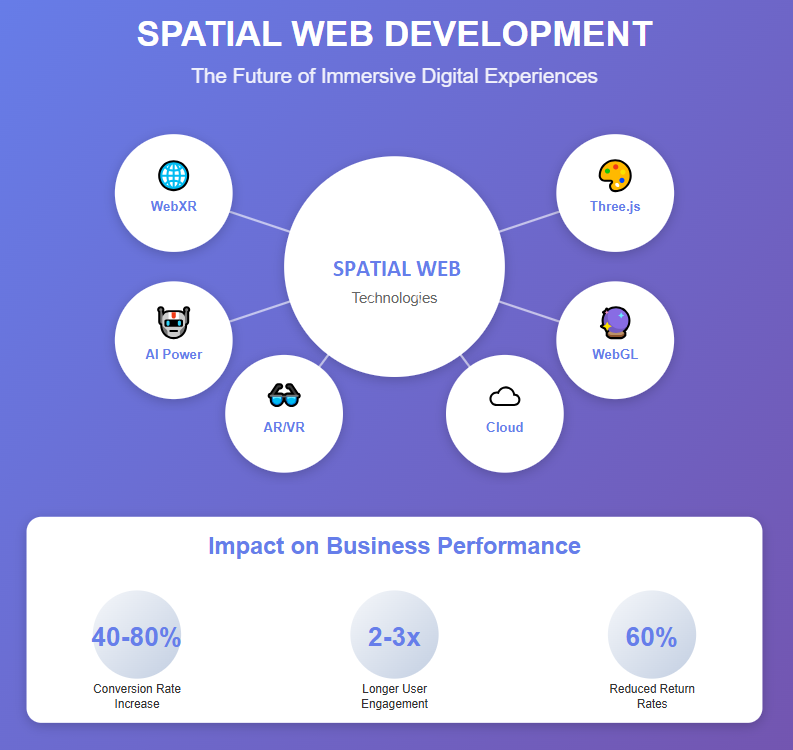
The internet as we know it is undergoing a profound transformation. Where we once navigated through pages and scrolled through content on two-dimensional screens, we're now stepping into environments where digital experiences exist in three-dimensional space. This evolution, known as spatial web development, represents perhaps the most significant shift in how humans interact with technology since the advent of the smartphone.
Spatial web development encompasses the creation of immersive 3D experiences that users can explore, manipulate, and interact with in ways that feel natural and intuitive. From virtual showrooms where customers can examine products from every angle to collaborative workspaces where teams meet as avatars, the spatial web is redefining what's possible online. For businesses seeking to stay ahead of the curve, investing in professional web development services that specialise in spatial technologies is becoming increasingly critical.
Understanding the Spatial Web
The spatial web, sometimes called Web 3.0 or the metaverse's technical foundation, merges physical and digital realities through advanced technologies. Unlike traditional websites that exist on flat screens, spatial web experiences create environments where users have depth perception, spatial awareness, and the ability to interact with digital objects as though they occupied physical space.
This paradigm shift is powered by several converging technologies. WebGL and WebXR enable browsers to render complex 3D graphics without requiring special plugins, whilst augmented reality (AR) overlays digital information onto the physical world through smartphone cameras or AR glasses. Virtual reality (VR) creates fully immersive digital environments, and artificial intelligence helps these spaces respond intelligently to user behaviour.
According to The Khronos Group, the organisation behind WebGL standards, browser-based 3D rendering capabilities have advanced to the point where experiences that once required powerful gaming computers can now run smoothly on standard devices. This democratisation of access is accelerating adoption across industries.

Real-World Applications Transforming Industries
The practical applications of spatial web development extend far beyond gaming and entertainment. Retail brands are creating virtual showrooms where customers can examine products in exquisite detail, rotating items, changing colours, and visualising how furniture might look in their homes through AR. This isn't futuristic speculation—major Australian retailers are already implementing these technologies to reduce return rates and increase customer confidence.
Education and training have been revolutionised by spatial web experiences. Medical students can practise surgical procedures in risk-free virtual environments, whilst engineering apprentices can disassemble complex machinery to understand its inner workings. The Mozilla Developer Network highlights how educational institutions are leveraging WebXR to create accessible learning experiences that were previously cost-prohibitive.
In the property sector, virtual tours have evolved from simple 360-degree photos into fully interactive experiences. Prospective buyers can walk through properties, open cupboards, switch on lights, and even visualise renovations—all from their lounge room. Estate agents report that these immersive experiences significantly reduce time-wasters and attract more serious buyers.
Manufacturing and design teams are collaborating in virtual workspaces where they can manipulate 3D models together in real-time, regardless of physical location. This has profound implications for Australian businesses working with international partners or managing distributed teams across vast distances.

Technical Considerations for Development
Creating effective spatial web experiences requires careful consideration of several technical factors. Performance optimisation stands paramount, as 3D experiences demand significantly more processing power than traditional websites. Developers must balance visual fidelity with loading times and frame rates, ensuring experiences remain smooth even on mid-range devices.
Cross-platform compatibility presents another challenge. Users might access your spatial experience through desktop browsers, mobile devices, VR headsets, or AR glasses. Quality web development services employ progressive enhancement strategies, delivering basic functionality to all devices whilst enhancing the experience for those with more capable hardware.
Accessibility in spatial environments requires rethinking traditional approaches. How do screen readers interpret 3D spaces? What alternatives exist for users who experience motion sickness in VR? Forward-thinking developers are pioneering inclusive design patterns that ensure spatial web experiences remain accessible to everyone.
Data management and optimisation become critical when dealing with large 3D assets. Techniques like level-of-detail rendering, where objects display in higher quality when closer to the user, help manage bandwidth and processing requirements. Proper asset compression and lazy loading strategies ensure experiences launch quickly without sacrificing quality.
The Business Case for Spatial Web Development
Beyond the technical excitement, spatial web development offers tangible business benefits. Companies implementing 3D product visualisation report conversion rate increases of 40-80% compared to traditional product pages. The ability to interact with products virtually reduces uncertainty, the primary barrier to online purchasing for many consumers.

Customer engagement metrics tell a compelling story. Users spend 2-3 times longer in spatial web experiences compared to traditional websites, creating more opportunities for brand messaging and relationship building. This increased engagement translates directly to improved brand recall and customer loyalty.
Cost savings represent another significant advantage. Virtual training environments eliminate travel costs and equipment wear whilst allowing unlimited practice repetitions. Property developers save thousands on physical display suites by offering virtual alternatives. Product designers iterate faster by testing concepts in virtual space before committing to physical prototypes.
The competitive advantage of early adoption shouldn't be underestimated. Whilst spatial web development remains relatively nascent in Australia, businesses implementing these technologies now position themselves as innovators. As consumer expectations evolve, those without immersive experiences may appear outdated.
Challenges and Considerations
Despite its promise, spatial web development presents challenges that businesses must address thoughtfully. Development costs currently exceed those of traditional websites, though this gap narrows as tools and frameworks mature. Finding developers with spatial computing expertise can prove difficult, making partnerships with experienced web development services valuable.
User adoption varies across demographics. Whilst younger audiences embrace spatial experiences enthusiastically, older users may find them initially disorienting. Successful implementations provide clear onboarding and alternative navigation methods, ensuring nobody feels excluded.
Privacy and data security take on new dimensions in spatial computing. User movements, gaze patterns, and interaction data reveal far more about individuals than traditional analytics. Responsible developers implement robust privacy protections and transparent data practices from the outset.
Browser compatibility, whilst improving, remains imperfect. Safari's WebXR support lags behind Chrome and Edge, potentially limiting reach among Apple device users. Professional developers employ feature detection and graceful degradation to ensure basic functionality across all platforms.
Future Trends Shaping Spatial Development
The spatial web's trajectory points toward increasingly seamless integration between physical and digital realms. Advances in 5G connectivity will enable more complex experiences with minimal latency, crucial for real-time multi-user interactions. As WebXR standards evolve, we'll see richer sensory experiences incorporating haptic feedback and spatial audio.
Artificial intelligence will play an expanding role, creating responsive environments that adapt to individual users. Imagine virtual shopping assistants that remember your preferences, or training simulations that adjust difficulty based on your performance. These intelligent spatial experiences will feel less like visiting a website and more like entering a living environment.
The convergence of spatial web development with other emerging technologies—blockchain for digital ownership, IoT for real-world data integration, and edge computing for reduced latency—will unlock applications we're only beginning to imagine. Australian businesses that begin experimenting now will be best positioned to capitalise on these opportunities.

Getting Started with Spatial Web Development
For businesses considering spatial web development, starting with a clear use case proves more effective than attempting everything at once. Identify specific customer pain points or business processes that three-dimensional interaction could improve. Perhaps customers struggle to visualise product dimensions, or training costs are prohibitive, or remote collaboration feels disconnected.
Begin with pilot projects that demonstrate value without requiring wholesale digital transformation. A single product line with 3D visualisation, a virtual tour of one property, or a focused training module allows you to test the waters, gather user feedback, and refine your approach before scaling.
Partner with web development services that possess genuine spatial computing expertise rather than attempting to upskill existing teams from scratch. The learning curve is steep, and experienced developers will help you avoid costly mistakes whilst accelerating time to market. Look for portfolios demonstrating actual spatial web projects, not just traditional website development.
Invest in analytics and feedback mechanisms from day one. Understanding how users interact with spatial experiences—where they look, what they touch, where they struggle—provides invaluable insights for refinement. This data helps justify continued investment and guides future development priorities.
Quick Q&A: Spatial Web Development Essentials
Q: How much does spatial web development typically cost compared to traditional website development?
A: Spatial web development generally costs 1.5 to 3 times more than traditional website development, depending on complexity. A basic 3D product visualisation might add $5,000-$15,000 to your project, whilst fully immersive virtual environments can range from $30,000-$100,000+. However, businesses typically see ROI within 6-12 months through increased conversions, reduced product returns, and enhanced customer engagement. The key is starting with focused use cases that address specific business challenges rather than attempting comprehensive spatial experiences immediately. Many web development services offer pilot projects that allow you to test the waters before committing to larger investments.
Q: Do users need special equipment or software to access spatial web experiences?
A: No special equipment is required for most spatial web experiences. Modern browsers on standard smartphones, tablets, and computers can render 3D content through WebGL and WebXR technologies without any downloads or plugins. Users simply visit your website as they normally would. For enhanced experiences, optional VR headsets or AR-enabled devices can provide deeper immersion, but your spatial web experience should be designed to work across all devices. This progressive enhancement approach ensures you're not excluding potential customers whilst still offering cutting-edge experiences to those with advanced hardware. Approximately 95% of internet users already have devices capable of viewing spatial web content.
Embracing the Spatial Future
The spatial web represents more than a technological novelty—it's a fundamental reimagining of how we interact with digital information. As browsers gain capabilities, devices become more powerful, and user expectations evolve, businesses without immersive experiences may find themselves at a significant disadvantage.
However, success in spatial web development requires more than simply adding a 3D element to your website. It demands thoughtful consideration of user needs, careful technical implementation, and ongoing refinement based on real-world usage. The businesses thriving in this new landscape will be those that view spatial development as a strategic initiative rather than a technical exercise.
For Australian businesses, the opportunity is particularly compelling. Our geographic isolation has long challenged traditional business models, but spatial web technologies collapse distance, enabling local companies to compete globally whilst providing unprecedented experiences for domestic customers. The question isn't whether spatial web development will become standard practice—it's whether your business will lead this transformation or struggle to catch up.
The future of the web is spatial, dimensional, and immersive. The tools exist today to begin building tomorrow's experiences. The only question remaining is: will you be among the pioneers shaping this new frontier, or will you watch from the sidelines as your competitors stake their claim?










